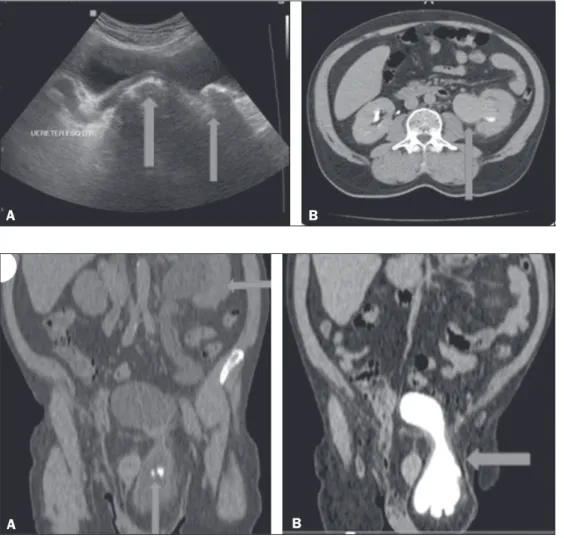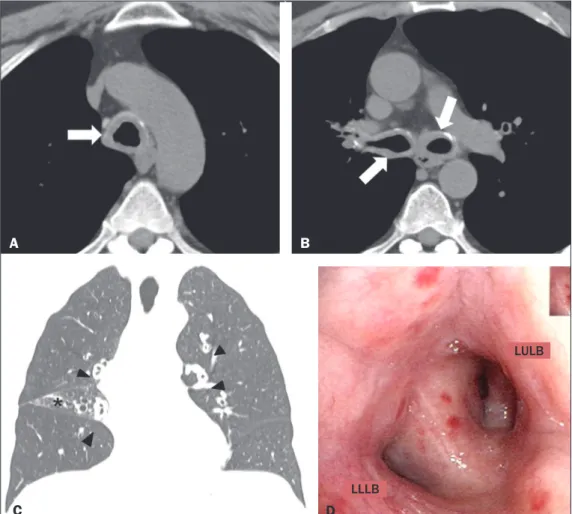266
Radiol Bras. 2017 Jul/Ago;50(4):266–276 Letters to the Editor0100-3984 © Colégio Brasileiro de Radiologia e Diagnóstico por Imagem
Letters to the Editor
Sliding inguinoscrotal hernia insinuating itself into the bladder, with calculi in the bladder and distal ureter
Dear Editor,
A 55-year-old male presented with dysuria, polyuria, noc-turia, and decreased urinary low. The physical examination revealed a large left-sided inguinoscrotal hernia that was irre-ducible, together a slightly enlarged prostate. Laboratory tests showed mild anemia and pyuria, as well as elevated concentra-tions of urea and creatinine. Ultrasound showed a left-sided inguinoscrotal hernia that had insinuated itself into the bladder, with dilation of the distal ureteral segment and two calculi, one measuring approximately 2.2 cm, at the ureterovesical junction, and the other, of similar diameter, free within the bladder (Fig-ure 1A). Computed tomography (CT) showed a illing delay and dilation of the renal pelvis (Figure 1B), as well as two calculi in the herniated bladder, one of which was at the left ureterovesi-cal junction, with dilation of the renal excretory pathway in the coronal reconstruction (Figures 2A and 2B). On the basis of the information observed in the images, the decision was made to submit the patient to cystolithotomy in the region of the herni-ated bladder, removal of the calculi from the bladder and ureter (with Randall forceps), and correction of the inguinal hernia by the Lichtenstein technique. Subsequently, the patient evolved satisfactorily.
Bladder hernias, which are not uncommon, protrude into the femoral canal in women and into the inguinal canal in
men(1). In the past, inguinoscrotal hernias of the bladder were diagnosed intraoperatively or through excretory urography and produced complications such as urinary tract infection and ob-structive uropathy(2–4). The preoperative diagnosis of a hernia insinuating itself into the bladder is very important for the urol-ogist, guiding the surgical planning(5).
The examinations most commonly performed in order to diagnose inguinoscrotal hernias are ultrasound and CT(6). Ul -trasound is a noninvasive test, useful for identifying a herniated bladder and its components, as well as the continuity of the bladder with the non-herniated portion within the pelvis, and can be used in emergency settings. The use of multidetector CT facilitates the diagnosis and in traumatic cases can show other herniations in the abdominal wall, through coronal and sagit-tal reconstructions. Because of its high resolution, multidetec -tor CT allows better visualization of the relationship between the bladder and the inferior epigastric vessels, thus facilitating the differentiation among direct inguinal, indirect inguinal, and femoral hernias(7). Magnetic resonance imaging can be used in place of CT. The combination of ultrasound and magnetic reso -nance imaging is useful for the noninvasive, nonradiative evalu-ation of alterevalu-ations in the scrotum(8).
In the case presented here, we have described the impor -tance of ultrasound for the diagnosis of a calculus within the lumen of the bladder and another at the ureterovesical junction, with upstream dilation of the renal excretory pathway, and for conirmation of the CT indings, which showed a calculus in the
Figure 1. A: Ultrasound showing a cal-culus within the bladder and another calculus at the ureterovesical junction, with upstream dilation of the renal ex-cretory pathway (arrows). B: Axial CT with delayed illing of the left renal pelvis (ar -row).
A
B
Figure 2. A: CT with coronal reconstruc-tion showing a left-sided inguinoscrotal bladder hernia containing a calculus, another calculus being seen at the ureterovesical junction (seen on ultra-sound), with upstream stasis, dilation, and tortuosity of the renal excretory pathway (arrows). B: Coronal CT recon-struction in the delayed phase conirm -ing the left-sided -inguinoscrotal hernia of the bladder (arrow).
267
Radiol Bras. 2017 Jul/Ago;50(4):266–276Letters to the Editor
http://dx.doi.org/10.1590/0100-3984.2015.0122 bladder and another at the left ureterovesical junction, contrib
-uting to the selection of appropriate practice and the success of the surgical procedure. In our review of the literature, we found no other reports of a ureteral calculus in a patient with inguino-scrotal hernia of the bladder.
REFERENCES
1. Levine B. Scrotal cystocele. J Am Med Assoc. 1951;147:1439–41. 2. Fisher PC, Hollenbeck BK, Montgomery JS, et al. Inguinal bladder hernia
masking bowel ischemia. Urology. 2004;63:175–6.
3. Huerta S, Fairbanks T, Cinat M. Incarcerated vesicoinguinal hernia pre
-senting with gross hematuria. J Am Coll Surg. 2005;201:992–3. 4. Kraft KH, Sweeney S, Fink AS, et al. Inguinoscrotal bladder hernias:
report of a series and review of the literature. Can Urol Assoc J. 2008;2: 619–23.
5. Ng AC, Leung AK, Robson WL. Urinary bladder calculi in a sliding ves
-Jose Domingos Contrera1, Francisco Teixeira Cardoso Sobrinho2
1. IDI – Instituto de Diagnóstico por Imagem, Ribeirão Preto, SP, Brazil. 2. Centro de Diagnóstico por Imagem, Parintins, AM, Brazil. Mailing address: Dr. Jose Do-mingos Contrera. Rua Pau Brasil, 432, Jardim Recreio. Ribeirão Preto, SP, Brazil, 14040-220. E-mail: jdcontrera@gmail.com.
ical-inguinal-scrotal hernia diagnosed preoperatively by plain abdominal
radiography. Adv Ther. 2011;24:1016–9.
6. Bacigalupo LE, Bertolotto M, Barbiera F, et al. Imaging of urinary bladder hernias. AJR Am J Roentgenol. 2005;184:546–51.
7. Burkhardt JH, Arshanskiy Y, Munson JL, et al. Diagnosis of inguinal re
-gion hernias with axial CT: the lateral crescent sign and other key ind
-ings. Radiographics. 2011;31: E1–12.
8. Resende DAQP, Souza LRMF, Monteiro IO, et al. Scrotal collections:
pictorial essay correlating sonographic with magnetic resonance imaging
indings. Radiol Bras. 2014;47:43–8.
Primary tracheobronchial amyloidosis
Dear Editor,
A 58-year-old male sought treatment complaining of dyspnea on exertion, together with cough and occasional mucus secre -tion. He reported having been treated for asthma 14 years prior, as well as having used bronchodilators and inhaled corticoste-roids, although he stated that he had experienced no asthma symptoms in childhood.
Computed tomography (CT) was performed (Figures 1A, 1B and 1C), after which the patient was submitted to bronchoscopy (Figure 1D) with biopsy. The CT showed concentric thickening
of the walls of the trachea, as well as of those of the main, lobar, segmental, and subsegmental bronchi, with small calciications. The bronchoscopy showed diffuse, concentric iniltration of the mucosa, the iniltrate having a grayish-yellow appearance. The histopathological study showed deposition of amorphous material, whose characteristics were compatible with amyloid deposits.
Amyloidosis encompasses a set of diseases characterized by deposition and abnormal accumulation of protein material in organs and tissues(1). Depending on the anatomical distribution, amyloidosis can be classiied as systemic (involving multiple or -gans) or localized (involving a single organ). In the biochemical
Figure 1. A,B: Axial CT scan of the chest (mediastinal window), without contrast administration, at the level of the proximal segment of the tra-chea (A) and below the carina (B), showing signiicant concentric thick -ening of the wall and small calciica -tions in the trachea and bronchi (ar-rows). C: Coronal CT scan of the chest (lung window) showing homogeneous wall thickening affecting the segmen -tal and subsegmen-tal bronchi (ar-rowheads). Signs of volumetric loss in the middle lobe (asterisk) due to narrowing of the lumen of respective lobar bronchus (not shown). D: Bron-choscopic image showing narrowing of the bronchial lumen by concentric, diffuse iniltration by grayish-yellow mucous, resulting in enlargement of the secondary carina. LULB, left up-per lobe bronchus; LLLB, left lower lobe bronchus.
A
B
C
D
LLLB

